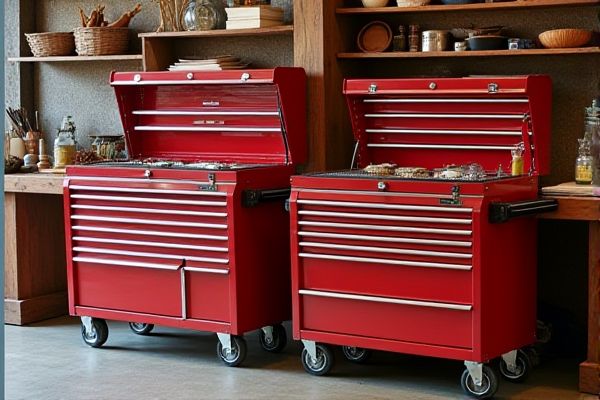
Choosing between a rolling tool chest and a stationary tool chest depends on your workspace flexibility and mobility needs, as rolling chests offer portability while stationary ones provide stable, permanent storage. Discover which tool chest best suits your workflow and organization by exploring the key features and benefits detailed in the rest of this article.
Table of Comparison
| Feature | Rolling Tool Chest | Stationary Tool Chest |
|---|---|---|
| Mobility | High - Equipped with wheels for easy movement | Low - Fixed position, no wheels |
| Space Efficiency | Compact and easy to relocate | Generally larger, demands dedicated space |
| Weight Capacity | Moderate - Limited by wheel strength | High - Supports heavier tools without mobility concern |
| Use Case | Ideal for workshops needing flexibility | Best for permanent workshop setups |
| Durability | Good - May experience wear on wheels | Excellent - Stable and robust construction |
| Cost | Generally lower to mid-range | Typically higher due to size and material |
Overview: Rolling Tool Chest vs Stationary Tool Chest
Rolling tool chests offer mobility, allowing you to easily transport tools across your workspace, while stationary tool chests provide a stable, fixed storage solution ideal for organized tool management in one location. The choice depends on your workshop layout and workflow needs, with rolling chests often favored for dynamic environments and stationary chests preferred for permanent setups. Consider the size, weight capacity, and durability of both options to optimize your tool storage efficiency.
Key Differences Between Rolling and Stationary Tool Chests
Rolling tool chests offer mobility with built-in casters that allow easy transportation across workshops, making them ideal for dynamic work environments. Stationary tool chests provide enhanced stability and larger storage capacity, designed to remain fixed in one location for organized, long-term tool management. Key differences include portability, storage volume, and workspace adaptability tailored to specific user needs.
Storage Capacity Comparison
Rolling tool chests typically offer moderate storage capacity with the advantage of mobility, allowing tools to be easily transported across workspaces. Stationary tool chests generally provide larger storage capacity, accommodating a wider range of tools and accessories due to their fixed position and often bigger size. Choosing between the two depends on prioritizing either portability or maximizing organized storage space for tool collections.
Durability and Build Quality
Rolling tool chests are designed with reinforced steel frames and heavy-duty casters, providing mobility without compromising durability. Stationary tool chests often feature thicker steel construction and welded drawers, offering superior build quality for long-term tool storage. Your choice depends on whether mobility or maximum structural strength is the priority for your workspace.
Mobility and Ease of Movement
A rolling tool chest offers superior mobility, allowing you to easily transport your tools across your workspace without heavy lifting. Stationary tool chests, while stable and often larger, lack this portability, making them ideal for fixed workstations but less convenient for tasks requiring frequent movement. Your choice depends on whether ease of movement or static storage best fits your workflow demands.
Space Efficiency and Footprint
Rolling tool chests offer superior space efficiency by providing mobility, allowing users to easily move tools to different workstations and store them in compact areas when not in use. Stationary tool chests typically occupy a fixed footprint, requiring dedicated floor space that can limit workspace flexibility in smaller garages or workshops. Choosing a rolling tool chest can optimize workspace by minimizing clutter and maximizing tool accessibility without permanently sacrificing valuable floor area.
Accessibility and Organization Features
Rolling tool chests offer enhanced accessibility with wheels that allow you to position tools closer to your workspace, reducing downtime and increasing efficiency. Stationary tool chests provide superior organization features, often featuring multiple drawers and compartments designed for long-term tool storage and easy categorization. Your choice depends on whether mobility or comprehensive organization is a priority for your workshop needs.
Security and Locking Mechanisms
Rolling tool chests often feature integrated locking systems that secure drawers simultaneously, providing convenience and enhanced security especially when moved around a workspace. Stationary tool chests typically use more robust locks, including tubular or cam locks, which offer stronger protection against unauthorized access due to their fixed position. Your choice should consider how frequently you need to relocate tools and the level of security required to safeguard valuable equipment.
Ideal Use Cases for Each Type
Rolling tool chests are ideal for mechanics, technicians, or DIY enthusiasts who require mobility and easy access to tools across different workstations, allowing you to transport tools effortlessly in garages or workshops. Stationary tool chests are best suited for permanent setups in industrial environments or home workshops where maximizing storage capacity and tool organization in a fixed location is essential. Choosing between the two depends on your workflow needs: portability and frequent relocation versus stability and extensive storage.
Choosing the Best Tool Chest for Your Needs
Choosing the best tool chest depends on your workspace and mobility requirements, with rolling tool chests offering portability through wheels and ease of movement across different job sites, while stationary tool chests provide sturdier storage with greater weight capacity and durability for fixed workbenches. Evaluate the frequency of tool transport, available storage space, and desired organization features to match your workflow effectively. Prioritize features like lockable drawers, material quality, and size to ensure your chosen tool chest enhances efficiency and tool accessibility.
 homyna.com
homyna.com